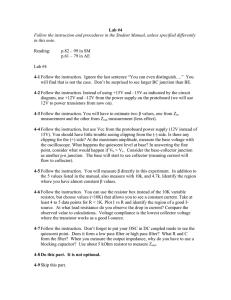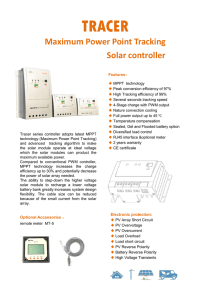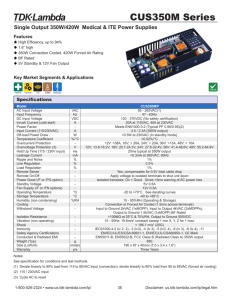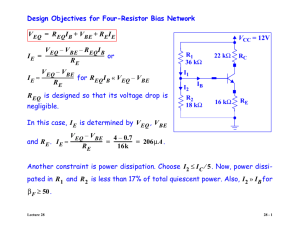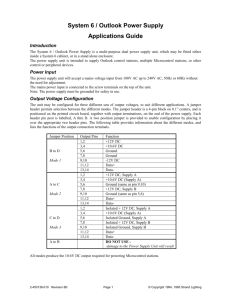12V/300W uTCA PRD1329 Reference design for uTCA FEATURES
advertisement
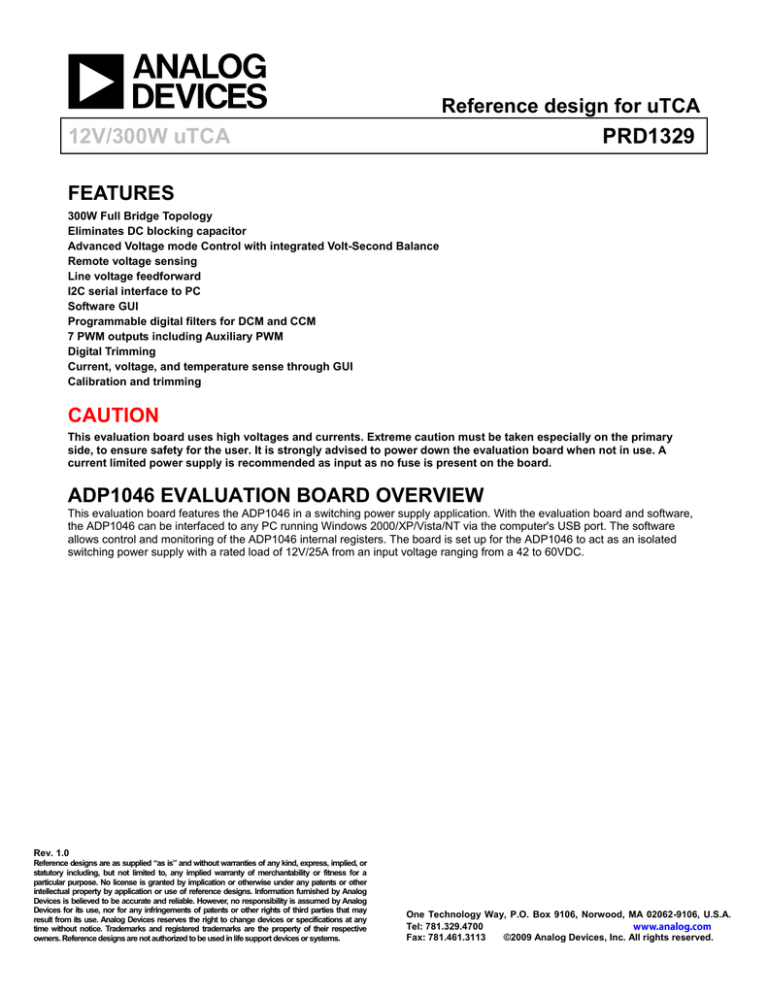
Reference design for uTCA 12V/300W uTCA PRD1329 FEATURES 300W Full Bridge Topology Eliminates DC blocking capacitor Advanced Voltage mode Control with integrated Volt-Second Balance Remote voltage sensing Line voltage feedforward I2C serial interface to PC Software GUI Programmable digital filters for DCM and CCM 7 PWM outputs including Auxiliary PWM Digital Trimming Current, voltage, and temperature sense through GUI Calibration and trimming CAUTION This evaluation board uses high voltages and currents. Extreme caution must be taken especially on the primary side, to ensure safety for the user. It is strongly advised to power down the evaluation board when not in use. A current limited power supply is recommended as input as no fuse is present on the board. ADP1046 EVALUATION BOARD OVERVIEW This evaluation board features the ADP1046 in a switching power supply application. With the evaluation board and software, the ADP1046 can be interfaced to any PC running Windows 2000/XP/Vista/NT via the computer's USB port. The software allows control and monitoring of the ADP1046 internal registers. The board is set up for the ADP1046 to act as an isolated switching power supply with a rated load of 12V/25A from an input voltage ranging from a 42 to 60VDC. Rev. 1.0 Reference designs are as supplied “as is” and without warranties of any kind, express, implied, or statutory including, but not limited to, any implied warranty of merchantability or fitness for a particular purpose. No license is granted by implication or otherwise under any patents or other intellectual property by application or use of reference designs. Information furnished by Analog Devices is believed to be accurate and reliable. However, no responsibility is assumed by Analog Devices for its use, nor for any infringements of patents or other rights of third parties that may result from its use. Analog Devices reserves the right to change devices or specifications at any time without notice. Trademarks and registered trademarks are the property of their respective owners. Reference designs are not authorized to be used in life support devices or systems. One Technology Way, P.O. Box 9106, Norwood, MA 02062-9106, U.S.A. Tel: 781.329.4700 Fax: 781.461.3113 ©2009 Analog Devices, Inc. All rights reserved. 12V/300W PRD1329 TABLE OF CONTENTS Features ....................................................................................................................................................................................... 1 CAUTION ..................................................................................................................................................................................... 1 TOPOLOGY AND circuit description ............................................................................................................................................ 3 CONNECTORS ............................................................................................................................................................................ 3 SETTING FILES AND EEPROM .................................................................................................................................................. 5 BOARD EVALUATION ................................................................................................................................................................. 6 EQUIPMENT ............................................................................................................................................................................ 6 SETUP...................................................................................................................................................................................... 6 BOARD SETTINGS .................................................................................................................................................................. 9 Theory of operation during startup ............................................................................................................................................... 9 FLAGS SETTINGS CONFIGURATIONS ................................................................................................................................ 10 PWM SETTINGS ....................................................................................................................................................................... 11 BOARD EVALUATION AND TEST DATA ................................................................................................................................... 12 STARTUP ............................................................................................................................................................................... 12 PRIMARY GATE DRIVER DEADTIME ................................................................................................................................... 13 CS1 PIN VOLTAGE (PRIMARY CURRENT) .......................................................................................................................... 14 SYnchronous rectifier peak inverse voltage ............................................................................................................................ 15 OUTPUT RIPPLE ................................................................................................................................................................... 15 TRANSIENT Voltage at 48VDC (NOMINAL VOLTAGE) ......................................................................................................... 17 LOAD STEP 0-25A ................................................................................................................................................................. 19 FEEDFORWARD .................................................................................................................................................................... 20 OUTPUT OVER CURRENT PROTECTION ........................................................................................................................... 20 CLOSED LOOP FREQUENCY RESPONSE .......................................................................................................................... 21 EFFICIENCY .......................................................................................................................................................................... 22 CS1 LINEARITY ..................................................................................................................................................................... 22 ACSNS LINEARITY ................................................................................................................................................................... 23 CS2 Linearity .............................................................................................................................................................................. 23 Thermal TEST DATA .................................................................................................................................................................. 24 APPENDIX I – SCHEMATIC (MAIN BOARD) ............................................................................................................................ 25 APPENDIX IV – LAYOUT ........................................................................................................................................................... 28 NOTES ....................................................................................................................................................................................... 31 REVISION HISTORY 10/22/2011—Revision 1.0: SPM 11/28/2011—Revision 1.1: SPM 08/03/2012—Revision 1.2: SPM 12V/300W PRD1329 BOARD SPECIFICATIONS Specification VIN MIN TYP MAX Units 42 48 60 V VOUT 10.8 12 13.2 V IOUT 0.0 25 25 A 0 50 50 ºC TAMBIENT Efficiency 93.5% Switching frequency 148.8 Output Voltage Ripple % Notes With 400 LFM air flow Typical reading at 48V/25A load KHz 100 mV At 25A load TOPOLOGY AND CIRCUIT DESCRIPTION This application note consists of the ADP1046 in a typical DC/DC switching power supply in a full bridge topology with synchronous rectification. The circuit is designed to provide a rated load of 12V/25A from an input voltage source of 42V to 60VDC. The ADP1046 is used to provide functions such as the output voltage regulation, output over voltage and current protection, primary cycle by cycle protection, and over temperature protection. The auxiliary power supply using transformer (T3) and IC (U10) generates 12V rails on both the primary and secondary side to power the i-couplers and MOSFET drivers. This auxiliary supply starts up at approximately 30VDC. The primary side consists of the input terminals (JP1, JP3), switches (Q1-Q4), the current sense transformer (T1) and the main transformer (T2). The ADP1046 resides on the secondary side and is powered via the auxiliary power supply or the USB connector via the LDO (U11). The gate signal for the primary switches is generated by the ADP1046 through the i-couplers (U2, U3) and fed into the MOSFET drivers (U1, U4). The secondary side power stage consists of the synchronous rectifiers (M1, M2, M5, M6). The RCD snubber (D2, D5, C22, C23, R17, R19, R62, R63) act as snubbers for these FETs. The secondary side FETs are driven by driver (U5). Also present on the secondary side is the output filter inductor (L3) and the output capacitors (C16-C21). Capacitor (C52) provides high frequency decoupling to lower EMI. The primary current is sensed through the CS1 pin with a small RC time constant (R25, C25) that filters the noisy signal. The secondary current is sense across resistors (R29, R21) and fed in the CS2± pins. The output voltage can be sensed locally or remotely by removing resistors R23 and R38 and connecting Vsen+ and Vsen- to the remote sensing point on connector (JP10). Fast OVP is implemented using the VS1 pin and regulation is achieved using VS3 pin. The output voltage is divided to a nominal of 1V before feeding into the appropriate pins. Line voltage feedforward is implemented using an RCD circuit (D3, R95, R96, C62, C64) that detects the peak voltage at the synchronous FET. There are two time constants. The time constants must be matched such that it retains the peak value during the switching frequency period but also is not too long in case there is a step down change in the input voltage. This peak voltage is further ratioed and fed in the ACSNS pin of the controller (ADP1046). A thermistor (RT1) is placed on the secondary side close to synchronous FET and acts thermal protection for the power supply. A 16.5k resistor is placed in parallel with the thermistor that allows the software GUI to read the temperature directly in degrees Celsius. Also present on the secondary is a 4 pin connector for I2C communication. This allows the PC software to communicate with the IC through the USB port of the PC. The user can easily change register settings on the ADP1046, and monitor the status registers. It is recommended that the USB dongle be connected directly to the PC, not via external hub. Jumper JP2 acts as a hardware PS_OFF switch. When tied to ground, the voltage reference (D10) stops sinking current, turning transistor (Q5) off, and thus the optocoupler (U7) off as well. The voltage at the PSON pin is now low and the power supply is turned off. CONNECTORS The following table lists the connectors on the board: 12V/300W PRD1329 Connector Evaluation Board Function JP1 Positive 48V DC Input JP3 Return for 48V DC Input JP8 12V isolated output JP4 Return for 12V DC Voltage Output JP10 I2C Connector JP2 Hardware on/off The pin outs of the USB dongle are given below: Figure 1 – I2C connector (pin1 on left) Pin (left to right) Function 1 5V 2 SCL 3 SDA 4 Ground 12V/300W PRD1329 SETTING FILES AND EEPROM The ADP1046 communicates with the GUI software using the I2C bus. The register settings (having extension .46r) and the board settings (having extension .46b) are two files that are associated with the ADP1046 software. The register settings file is contains information such as the over voltage and over current limits, softstart timing, PWM settings etc. that govern the functionality of the part. The ADP1046 stores all its settings in the EEPROM. The EEPROM on the ADP1046 does not contain any information about the board, such as current sense resistor, output inductor and capacitor values. This information is stored in board setup file (extension .46b) and is necessary for the GUI to display the correct information in the ‘Monitor’ tab as well as ‘Filter Settings’ window. The entire status of the power supply such as the ORFET and synchronous rectifiers enable/disable, primary current, output voltage and current can be thus digitally monitored and controlled using software only. Always make sure that the correct board file has been loaded for the board currently in use. Each ADP1046 chip has trim registers for the temperature, input current and the output voltage and current, and ACSNS. These can be configured during production and are not overwritten whenever a new register settings file is loaded. This is done in order to retain the trimming of all the ADCs for that corresponding environmental and circuit condition (component tolerances, thermal drift, etc.). A guided wizard called the ‘Auto Trim’ is started which trims the above mentioned quantities so that the measurement value matches the valued displayed in the GUI to allow ease of control through software. 12V/300W PRD1329 BOARD EVALUATION EQUIPMENT • DC Power Supply (40-60V, 400W) • Electronic Load (25A/300W) • Oscilloscope with differential probes • PC with ADP1046 GUI installed • Precision Digital Voltmeters (HP34401or equivalent - 6 digits) for measuring DC current and voltage SETUP NOTE: DO NOT CONNECT THE USB CABLE TO THE EVALUATION BOARD UNTIL THE SOFTWARE HAS FINISHED INSTALLING 1) Install the ADP1046 software by inserting the installation CD. The software setup will start automatically and a guided process will install the software as well as the USB drivers for communication of the GUI with the IC using the USB dongle. 2) Insert the daughter card in connector J5 as shown in Figure 4 3) Ensure that the PS_ON switch (SW1 on schematic) is turned to the OFF position. It is located on the bottom left half of the board. 4) Connect one end of USB dongle to the board and the other end to the board to the USB port on the PC using the “USB to I2C interface” dongle. 5) The software should report that the ADP1046 has been located on the board. Click “Finish” to proceed to the Main Software Interface Window. The serial number reported on the side of the checkbox indicates the USB dongle serial number. The windows also displays the device I2C address. 5. If the software does not detect the part it enters into simulation mode. Ensure that the connecter is connected to J10 (on main board) or J7 (on daughter card). Click on ‘Scan for ADP1046 now’ icon (magnifying glass) located on the top right hand corner of the screen. 12V/300W PRD1329 5. Click on the “Load Board Settings” icon (fourth button from the left) and select the ADP1046_uTCA_C_xxxx.46b file. This file contains all the board information including values of shunt and voltage dividers. Note: All board setting files have an extension of .46b 6. The IC on the board comes preprogrammed and this step is optional. The original register configuration is stored in the ADP1046_uTCA_C_xxxx.46r register file (Note: All register files have an extension of .46r). The file can be loaded using the second icon from the left in Figure 6. 7. Connect a DC power source (48VDC nominal, current limit to ~1A) and an electronic load at the output set to 1 Ampere. 8. Connect a voltmeter on test points TP8(+) and TP4(-). Ensure that the differential probes are used and the ground of the probes are isolated if oscilloscope measurements are made on the primary side of the transformer. 9. Click on the Dashboard settings (3rd icon in Figure 5 and turn on the software PS_ON) 10. The board should now up and running, and ready for evaluation. The output should now read 12 VDC. 11. Click on the ‘MONITOR’ tab and then on the Flags and readings icon. This window provides a snapshot of the entire state of the PSU in a single user friendly window. 12V/300W PRD1329 12V/300W PRD1329 BOARD SETTINGS The following screenshot displays the board settings. THEORY OF OPERATION DURING STARTUP The following steps briefly describe the startup procedure of the ADP1046 and the power supply and the operation of the state machine for the preprogrammed set of registers that are included in the design kit. 1. After VDD (3.3V) is applied to the ADP1046 it takes approximately 20µs for VCORE to reach 2.5V. The digital core is now activated and the contents of the registers are downloaded in the EEPROM. The ADP1046 is now ready for operation. 2. PS_ON is applied. The power supply begins the programmed softstart ramp of 40ms (programmable). 3. Since the ‘softstart from pre-charge’ setting is active the output voltage is sensed before the softstart ramp begins. Depending upon the output voltage level of the effective softstart ramp is reduced by the proportional amount. 4. The PSU now is running in steady state. PGOOD1 turns on after the programmed debounce. 5. If a fault is activated during the softstart or steady state, the corresponding flag will be set and the programmed action will be taken such as disable PSU and re-enable after 1 sec, Disable SR and OrFET, Disable OUTAUX etc. 12V/300W PRD1329 FLAGS SETTINGS CONFIGURATIONS Basically when a flag is triggered, the ADP1046 state machine waits for a programmable debounce time before taking any action. The response to each flag can be programmed individually. The flags can be programmed in a single window by hitting the FLAG SETTINGS icon in the MONITOR tab in the GUI. This monitor window shows all the fault flags (if any) and the readings in one page. The ‘Get First Flag’ button determines the first flag that was set in case of a fault event. 12V/300W PRD1329 PWM SETTINGS The ADP1046 has a fully programmable PWM setup that controls 7 PWMs. Due to this flexibility the IC can function in several different topologies such as any isolated buck derived topology, push pull, flyback and also has the control law for resonant converters. The integrated volt-second balance feature is used as a current balancer of the two legs of the full bridge topology. Each PWM edge can be moved in 5ns steps to achieve the appropriate deadtime needed and the maximum modulation limit sets the maximum duty cycle. PWM Switching element being controlled OUTA-OUTD Primary switch PWM SR1-SR2 Synchronous rectifier PWMs OUTAUX N/A 12V/300W BOARD EVALUATION AND TEST DATA STARTUP PRD1329 12V/300W PRIMARY GATE DRIVER DEADTIME PRD1329 12V/300W CS1 PIN VOLTAGE (PRIMARY CURRENT) PRD1329 12V/300W SYNCHRONOUS RECTIFIER PEAK INVERSE VOLTAGE OUTPUT RIPPLE PRD1329 12V/300W PRD1329 12V/300W TRANSIENT VOLTAGE AT 48VDC (NOMINAL VOLTAGE) LOAD STEP OF 0-25% LOAD STEP OF 25-50% PRD1329 12V/300W LOAD STEP OF 50-75% PRD1329 12V/300W LOAD STEP OF 75-100% LOAD STEP 0-25A PRD1329 12V/300W FEEDFORWARD OUTPUT OVER CURRENT PROTECTION PRD1329 12V/300W PRD1329 CLOSED LOOP FREQUENCY RESPONSE A network analyzer (AP200) was used to test the bode plots of the system. A continuous noise signal of 300mV was injected across the entire frequency range across R35 using an isolation transformer with R38 shorted. The operating condition was 48VDC input and a load condition of 25A. 12V/300W EFFICIENCY CS1 LINEARITY PRD1329 12V/300W ACSNS LINEARITY CS2 LINEARITY PRD1329 12V/300W PRD1329 THERMAL TEST DATA A thermal snapshot of the unit was taken after running at 25A for 1 hour of soaking time with air flow of 200LFM. 12V/300W PRD1329 APPENDIX I – SCHEMATIC (MAIN BOARD) CS+ Vin+ 1 1 2 1 3 Vin+ T1 Q1 BSC060N10NS3 8 6 5 4 7 JP1 PA1005.100NL R1 4.7 R2 10K R3 4.7 Q3 BSC060N10NS3 R4 10K T2 7 Gate1 SW1 C2 C60 1.5uF 1.5uF C1 C4 1.5uF 1.5uF C5 1.5uF Gate3 1 C6 1.5uF SW2 6 5 TR5 4 TR4 3 TR3 2 RM8 Q2 BSC060N10NS3 Q4 BSC060N10NS3 3V3_SEC Vin+ R5 4.7 R6 10K R7 4.7 R8 10K VinCS+ AGND Vin- 1 1 Vin- Gate2 Gate4 PGND JP3 12V_PRI C7 0.1uF VDD HB HO HS NC1 10 9 8 7 6 LO VSS LI HI NC2 11 SW1 1 2 3 4 5 PAD Gate1 OUTA U1 Gate2 LM5101A R9 0 5V_PRI R10 0 C8 0.1uF VDD2VDD1 VOA VIA VOB VIB GND2GND1 OUTB 3V3_SEC U2 8 7 6 5 OUTC 1 2 3 4 OUTA OUTB 12V_PRI C9 0.1uF ADUM3200 C10 1uF OUTD 5V_PRI TR5 TR4 Gate4 VDD HB HO HS NC1 LO VSS LI HI NC2 PAD C11 0.1uF U4 11 Gate3 SW2 1 2 3 4 5 C14 1uF TR3 10 9 8 7 6 LM5101A R11 0 5V_PRI 8 7 6 5 R12 0 C12 0.1uF 3V3_SEC U3 VDD2VDD1 VOA VIA VOB VIB GND2GND1 ADUM3200 1 2 3 4 OUTC OUTD C13 0.1uF 0 Vin+ VinCS+ AGND PGND OUTA OUTB OUTC OUTD 12V_PRI 3.6V_SEC 0 12V_PRI 3V3_SEC 5V_PRI TR5 TR4 TR3 12V/300W PRD1329 L3 2.3uH Vout+ TR4 1 Vout+ 1 JP8 M1 BSC047N08NS3 TR5 CS2- CS2- CS2+ M2 BSC047N08NS3 CS2+ 1 VSS VSS VSO D2 MURA110 C17 2 C16 10uF/16V 10uF/16V C18 68uF CMAX VSO Vout+ Vout+ VoutR58 2 R59 R14 2 Vout- TR7 R19 10K 10K TR7 TR6 TR6 TR5 10K R17 M5 BSC047N08NS3 TR3 R62 TR5 TR4 C20 C19 10uF/16V 10K C21 68uF CMAX 10uF/16V TR4 TR3 TR3 SR1 SR1 SR2 M6 BSC047N08NS3 C22 33nF R63 10K SR2 PSON CS2- PSON CS2+ 12V_SEC 12V_SEC PGND R60 2 R61 2 D5 MURA110 1 2 R18 10K C23 33nF R29 2m R21 2m PGND AGND R31 R28 4.99K 4.99K 0.1% 0.1% VSS PGND 1 1 AGND Vout- JP4 VSS R22 10 PSON #OTW U5 ADP3634 EN INA GND INB PAD 12V_SEC OTW OUTA VS OUTB 1 2 3 4 SR1 C24 1uF SR2 R87 0 9 8 7 6 5 VSS T3 Vin+ 1 D15 BAV70WT1 VSS 12V_SEC R77 20K R76 20K C41 470pF/250V D16 MMBD1504A Vin+ 12V_PRI 2 3 5 4 C43 10uF/16V 12V_PRI 5V_PRI R88 1K 3.6V_SEC 5V_PRI 3V3_SEC 3 R78 1M VSS Vin+ 6 3V3_SEC 12V_SEC 12V_SEC ER11 EN_LDO D17 BAV70WT1 VD GND VCC CT UV VFB OV COM U10 9 PAD 1 2 3 4 R79 20K C47 0.1uF C50 1nF R83 10K R80 680 C49 R82 5.1K C48 R81 680 D8 1N4148WS Vin- 2 3.6V_SEC 3.6V_SEC 5V_PRI 12V_VCC C51 0.1uF R84 55K C52 1000pF/2000V 12V_SEC U11 3V3_SEC 1 2 3 EN_LDO4 2 1 VSS C53 220pF PGND Vin- 0 3 C46 0.1uF 8 7 6 5 AGND PGND D19 MMBZ5227BL/3.6V 10uF/16V 12V_VCC C45 390pF 10uF/16V NCP1031 EN_LDO AGND 1 12V_PRI D18 MMBZ5231BLT/5.1V R85 10K R86 36K GND IN OUT EN GND4 GND3 GND2 GND1 8 7 6 5 ADP1720ARMZ-3.3-R7 AUX Power C54 1uF C55 1uF C56 0.1uF 3.3V LDO 0 12V/300W PRD1329 VSO CS2- D6 BAS21W-7-F 200V CS2+ R96 47 Vout+ R25 680 R30 10 R44 10 C25 100pF Vout+ R23 10 C62 2200pF Vsen+ R74 DNI VS1 R27 4.7K D3 MURA110 TR3 C64 2200pF R24 11K R26 14.7K CS+ R95 100 VSO VS3+ TR3 C58 1nF C66 1000pF R32 1K PGND R35 11K R33 1K C65 1000pF TR3 CS2- CS2- CS2+ CS2+ VSO VSO VS3+ SR1 R71 10K SR2 Vout+ R73 10K C59 1nF 0 Vout+ Vout- R37 1K Vout- 16 1 VS3+ VS3- 7 CS1 VCORE R38 32 OUTA 12 OUTB 13 OUTC 14 OUTD OUTAUX 15 VDD 31 DGND ADP1046 OUTC AGND OUTD TPAD C63 0.1uF PGOOD1 PSON C26 0.47uF 25 33 R93 2.2K Share 23 PGND JP9 SHORTPIN 0 AGND 0 AGND OUTD 3V3_SEC 12V_SEC JP10 R67 100 R43 2.2K 0 0 C29 33pF D4 1N4148WS C31 33pF 0 1 3 5 7 2 4 6 8 PGOOD Vsen+ VsenR66 0 5V 0 R70 100 C30 33pF 0 R65 16.5K OUTC SDA 24 SCL 2 3V3_SEC 3V3_SEC 12V_SEC R68 0 PGND1 OUTB OUTD 0 PGND OUTA OUTB OUTC C28 33pF R42 10K 0.1% 0 PGOOD OUTA 0 2 SDA R41 10K 0.1% C27 0.33uF PSON TR4 PGND R39 2.2K 18 17 30 SCL RES ADD RTD R40 2.2K ADD 29 3V3_SEC 28 22 PGOOD2 FLAGIN 21 20 PSON 19 R64 10K SHAREi SR2 TR4 27 AGND SR1 SR2 PSON OUTAUX SHAREo SR1 26 OUTA OUTB 10 VS3- 3V3_SEC 11 CS+ AGND GATE VS2 3 PGND VS1 8 5 CS2- CS2+ 4 10 SR2 9 ACSNS U6 SR1 6 CS+ Vsen- Connector R45 2 DNI ADD R34 DNI Share 12V_SEC 0 RT1 100KOhm DGND R69 0 0 5V_PRI Ven CS+ R46 220K R49 10K 3V3_SEC R50 5.1K R51 8.2K Ven R52 1K ON/OFF 1 1 JP2 R57 220 R53 5.1K C33 10nF R54 5.1K Vin+ U7 PS2911 2 D11 BAV70WT1 C32 1uF CS+ EN_LDO 3V3_SEC 3.6V_SEC 1 D10 ZR431F01 Q5 MMBT2907AW1 4 R48 100K PSON 3 Vin+ EN_LDO R47 1K R55 220 Vin5V_PRI R56 5.1K C34 10nF C35 10nF PSON AGND 0 3.6V_SEC OUTAUX R36 Vin+ Vin5V_PRI PSON AGND 3.6V_SEC 12V/300W PRD1329 APPENDIX IV – LAYOUT The layout of the board was done on 14 layers with 3 ounce copper on the external layers. Some of the layers are shown below. 12V/300W PRD1329 12V/300W PRD1329 12V/300W NOTES PRD1329 ©2009 Analog Devices, Inc. All rights reserved. Trademarks and registered trademarks are the property of their respective owners.

